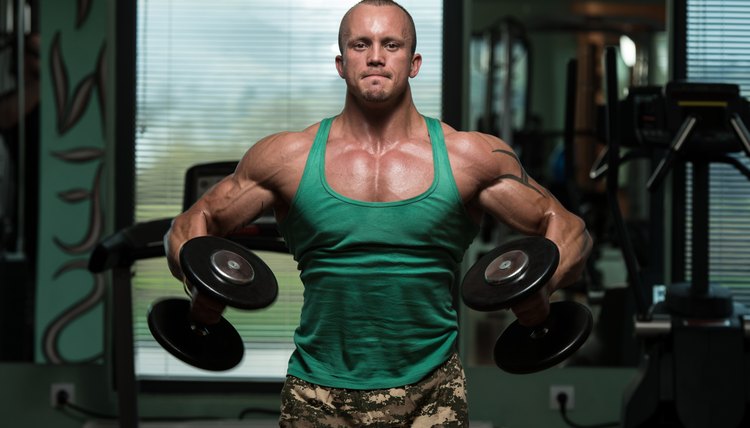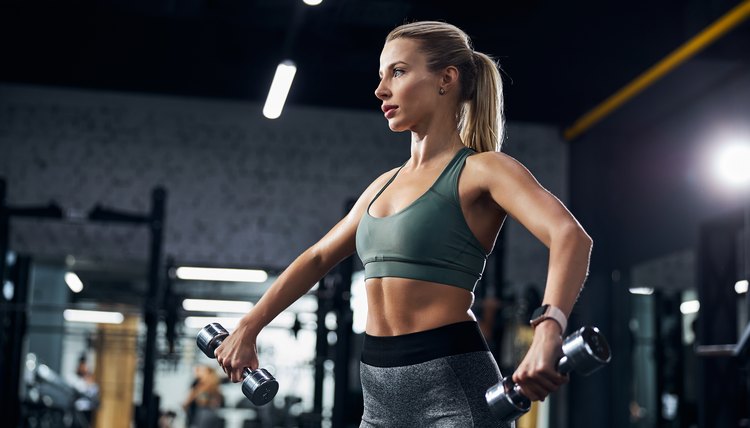What does fact checked mean?
At SportsRec, we strive to deliver objective content that is accurate and up-to-date. Our team periodically reviews articles in order to ensure content quality. The sources cited below consist of evidence from peer-reviewed journals, prominent medical organizations, academic associations, and government data.
The information contained on this site is for informational purposes only, and should not be used as a substitute for the advice of a professional health care provider. Please check with the appropriate physician regarding health questions and concerns. Although we strive to deliver accurate and up-to-date information, no guarantee to that effect is made.
Lateral Raise With Bent Arms

Lateral raises strengthen the stabilizing muscles in your shoulders and improve your upper body muscular balance. Your deltoids, or delts, muscle group will see the majority of growth in this shoulder workout, specifically the anterior delt, posterior deltoid, and lateral deltoid. A common mistake many make with weightlifting is underworking the lateral deltoid during compound exercises. Which makes this a great exercise to add to your workout routine.
Performing barbell, kettlebell, or dumbbell lateral raises with bent arms is one modification of this popular and effective exercise. You can also choose other variations to make the traditional lateral raise easier or more challenging. It is important, however, that you understand how to properly perform a standard lateral raise before you decide which strength training variation is best for your current fitness level and goals.
How to do lateral raise?
To do lateral raises, start by standing with your feet a little wider than hip-width distance apart. Taking into consideration your current fitness level, hold an appropriately weighted dumbbell in each hand or barbell in both and relax your arms by your sides. While keeping your core engaged, your shoulders back and down and your neck relaxed, perform a front raise by exhaling and lifting the dumbbells straight up and out to the sides. Keep your palms down and stop when you reach shoulder height. Inhale as you slowly lower the weights back to your starting position. Beginners should start with small repetitions, or reps, and lighter weight and work up as they learn the range of motion of this popular bodybuilding shoulder exercise.
Bending the arms

Ibrakovic/iStock/Getty Images
Naturally, if the standard lateral raise feels too difficult to perform with proper form, you can always use light weights. Another option, however, is to tweak your form and relieve upper arm load by bending your elbows. You can give a slight bend to your elbows or you can bend them as much as 90 degrees. Bending your elbows makes the exercise easier because you do not have to extend your arms as far away from your body. This eases the load lifted by the various components of the shoulder like the rotator cuff, shoulder joint, and the shoulder muscles like the rear delt. Try lateral raises with bent arms when you are working up to a heavier weight selection or when you are in the middle of a standard set and feel that you cannot maintain good form.
How to do Alternating lateral raise?
Another way to make this isolation exercise easier is to alternate sides. To perform alternating lateral raises, firmly plant your position by bending your knees and engaging your core. Using either the standard straight-arm option or the bent-arm variation, lift one dumbbell up and out by your side as you exhale. Inhale as you lower the weight back to your starting position. Repeat these steps using the other arm. Regardless of the type of lateral raise you perform, be sure that your wrist, elbow and shoulder are all level at the top of your movement so you can maximize hypertrophy.
Increase Your Load
When you have advanced past the alternating lateral raise, exceeded the bent-arm variation and feel that the standard lateral raise is like feather-lifting in the park, it may be time to increase your weight load. Try a set of standard lateral raises using dumbbells that are five pounds heavier. This should not only strengthen those delts but also work the trapezius muscle in the upper back and triceps. Also try finding other lateral raise variations that work for you like bent-over lateral raise, side lateral raise or cable lateral raise. Remember, as you work to increase your weight load, the bent-arm lateral raise is always an option as you work to get stronger. Also, be sure to consult a personal trainer before starting a workout routine.
References
Writer Bio
Mary Marcia Brown has worked in the health and fitness industry for more than 15 years. A writer and runner with road race directorship experience, Brown has been published in "Running Journal," "Florida Running & Triathlon" and "Outreach NC."
